Introduction: A Scottish Impressionist
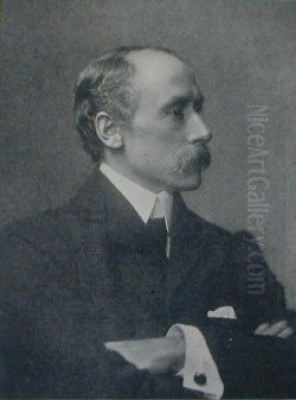
James Kay (1858-1942) stands as a significant figure in Scottish art history, a landscape painter whose reputation was forged in the dynamic, industrial heartland of the River Clyde. Active during a period of immense artistic change, from the late 19th century into the early 20th century, Kay absorbed the revolutionary spirit of Impressionism while forging a path marked by distinct originality. He is celebrated primarily for his vibrant, atmospheric depictions of the bustling shipping lanes and industrial vigour of the Clyde, capturing both the grandeur and the grit of this vital waterway. His work earned him considerable recognition during his lifetime, both within Scotland and on the international stage, cementing his place as an important interpreter of the Scottish landscape and its industrial identity.
Early Life and Artistic Formation
Born in 1858, James Kay emerged as an artist during a vibrant era for Scottish painting. While specific details about his earliest training are less documented than those of some contemporaries, his development occurred against the backdrop of the rise of the Glasgow School of painters, often known as the 'Glasgow Boys'. Though perhaps not a central member of that specific group, Kay undoubtedly breathed the same artistic air, one filled with a desire to break from staid Victorian academic traditions and embrace more modern, continental approaches to light, colour, and subject matter.
The late 19th century saw Glasgow rise as a major industrial and shipping powerhouse, the "Second City of the Empire." The River Clyde was its lifeblood, teeming with shipbuilding yards, docks, and vessels of all sizes. This environment, rich with visual drama – the smoke, the steam, the reflections on water, the monumental forms of ships – provided fertile ground for an artist keen on capturing contemporary life with immediacy and vigour. Kay's artistic sensibilities were clearly drawn to this potent mix of nature and industry.
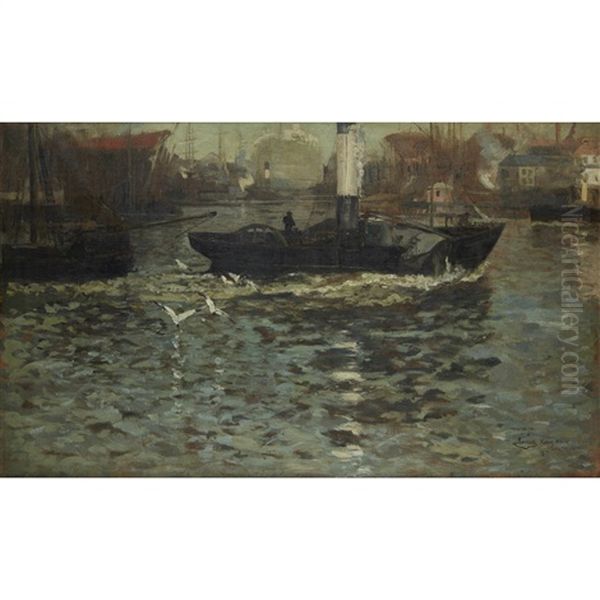
His formative years would have exposed him to the burgeoning influence of French Impressionism, news of which travelled through exhibitions, published articles, and the experiences of artists who had studied or travelled abroad. Figures like James Guthrie, John Lavery, and E. A. Walton were pioneering new approaches in Scotland, focusing on realism, plein air painting, and the effects of light. Kay absorbed these influences, adapting them to his own vision and temperament, particularly focusing on the unique atmospheric conditions offered by the Scottish climate and the industrial haze of the Clyde.
The Embrace of Impressionism and Originality
James Kay's work is often discussed in relation to Impressionism, and the influence is undeniable. He shared the Impressionists' fascination with capturing fleeting moments, the effects of light and atmosphere, and the vibrancy of modern life. Like Claude Monet painting the Gare Saint-Lazare or the Rouen Cathedral series, Kay found beauty and artistic challenge in subjects previously considered unpicturesque, such as industrial harbours and busy waterways.
However, Kay was noted for his "great originality." He did not simply mimic French Impressionism but adapted its principles to his specific Scottish context. His brushwork could be bold and energetic, applying paint thickly (impasto) in places to convey texture and solidity, while elsewhere using looser, more fluid strokes to capture the movement of water or the diffusion of light through mist and smoke. His palette, while often bright and responsive to light, could also incorporate the darker, more sombre tones characteristic of the industrial landscape and the often-overcast Scottish weather.
His focus on the Clyde allowed him to explore a wide range of light conditions – the sharp glare of a sunny day on water, the soft diffusion of light on a misty morning, the dramatic contrasts of twilight, or the artificial glow of lights at night. This sensitivity to atmospheric nuance is a hallmark of his style, lending his paintings a powerful sense of place and mood. He moved beyond mere topographical accuracy to convey the feeling and energy of the scenes he depicted.
The River Clyde: A Defining Muse
The River Clyde was undoubtedly James Kay's most significant and enduring subject. His paintings of the river are not just landscapes; they are portraits of an era and an artery of industrial life. He captured the relentless activity of the shipyards, the towering hulls of ships under construction or repair, the constant movement of ferries, tugboats, and larger vessels navigating the waterway. His works document the maritime power and industrial might of Glasgow and the surrounding region during its peak.
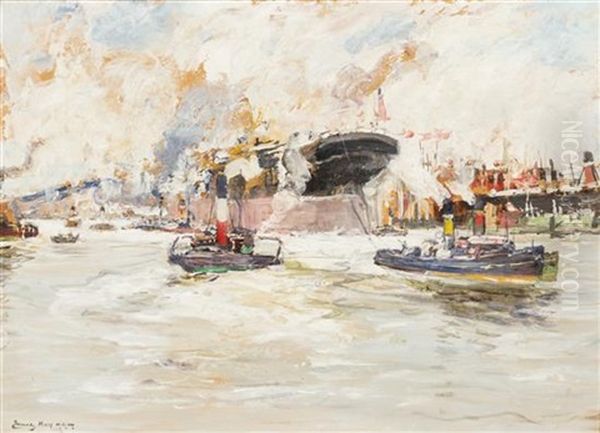
Paintings like Toil and Grime encapsulate this focus. The title itself suggests an unflinching look at the industrial reality, yet Kay finds visual poetry in these scenes. He masterfully depicted the interplay of smoke and steam mingling with natural cloud formations, the reflections of funnels and masts in the water, and the sheer scale of human enterprise set against the backdrop of the river and sky. He captured the energy, the noise (implied), and the often-grimy beauty of this working river.
His fascination extended along the Clyde, from the dense, urban docks of Glasgow out towards the Firth of Clyde, where the landscape opens up. He painted harbour scenes in towns like Greenock and Dumbarton, always sensitive to the specific character of each location. The recurring motif of shipping, whether a grand ocean liner or a humble fishing boat, ties much of his oeuvre together, showcasing his deep connection to the maritime life of Scotland's west coast.
Notable Works and Themes
Beyond the general theme of the Clyde, specific works highlight Kay's talent and interests. River of the North is another title indicative of his focus, suggesting a broader engagement with Scottish river landscapes, though the Clyde remained central. His painting Launch of the Lusitania, exhibited at the Royal Scottish Academy in 1907, demonstrates his ability to capture specific, momentous events. The RMS Lusitania, built on the Clyde at Clydebank, was one of the most famous ocean liners of its time, and its launch would have been a major spectacle. Kay's depiction likely conveyed the excitement and scale of the occasion, using his characteristic atmospheric style.
While maritime and industrial scenes dominate his best-known work, Kay also painted other subjects, including urban views and more traditional landscapes, often in Scotland but also during travels abroad, particularly in France and the Netherlands. These works further demonstrate his skill in handling light and colour across different environments. However, it is his powerful and evocative paintings of the Clyde that form the core of his artistic identity and legacy.
His medium was often oil paint, which allowed him the flexibility to build up textures and achieve rich colour effects. He was also a member of the Royal Scottish Society of Painters in Watercolour (RSW), indicating proficiency in that medium as well, likely used for sketches, studies, or finished works requiring a different quality of light and transparency.
Exhibitions and Recognition
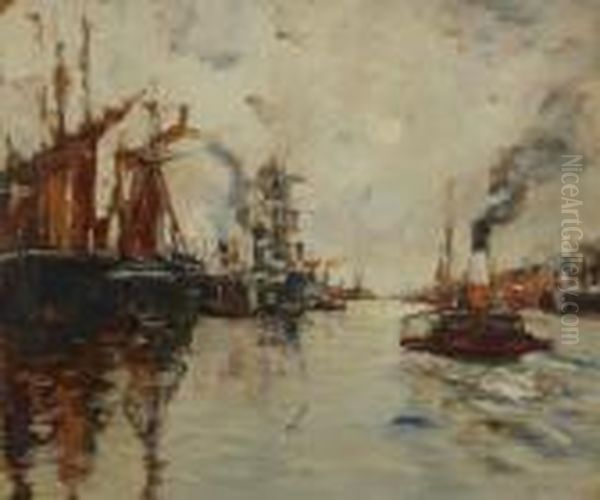
James Kay achieved significant recognition during his career, exhibiting widely and receiving accolades. His participation in the prestigious Paris Salon in 1894, 1895, and 1902 demonstrates his ambition and acceptance on an international level. The Paris Salon was a key venue for artists seeking to establish their reputations, and exhibiting there was a mark of distinction. Receiving an Honourable Mention at the La Libre Esthétique exhibition in Brussels in 1895 further solidified his standing outside of Britain.
Within Scotland and the UK, he was a regular exhibitor. His association with the Royal Scottish Academy (RSA) was crucial. He was elected an Associate (ARSA) and later a full Academician (RSA), titles signifying high esteem within the Scottish art establishment. He also exhibited frequently at the Royal Glasgow Institute of the Fine Arts. His membership in the Royal Scottish Society of Painters in Watercolour (RSW) further attests to his versatility and peer recognition.
These memberships and exhibition successes were vital. They provided platforms for selling work, building a reputation among critics and collectors, and engaging with the broader art community. The awards and honours he received confirmed the quality and originality perceived in his work by his contemporaries. His paintings were acquired by public collections, ensuring their visibility for future generations.
Professional Affiliations and Standing
Kay's professional standing is underscored by his memberships in key artistic bodies: the Royal Scottish Academy (RSA) and the Royal Scottish Society of Painters in Watercolour (RSW). Election to these institutions was, and remains, a significant honour, conferred by fellow artists based on the quality and consistency of one's work. These affiliations placed Kay firmly within the mainstream of the Scottish art world, even as his style embraced modern influences.
Furthermore, his role as President of the Scottish Modern Arts Association (SMAA) highlights his engagement with the contemporary art scene and his leadership qualities. The SMAA played a role in promoting modern art in Scotland, organising exhibitions and potentially acquiring works for public benefit. Holding the presidency indicates that Kay was respected not only for his own art but also for his commitment to the broader artistic community and the promotion of contemporary Scottish painting. This position would have put him in regular contact with a wide network of artists, critics, and administrators.
These affiliations demonstrate that Kay was not an isolated figure but an active participant in the institutional structures of the art world. His titles (RSA, RSW) would have added prestige to his name and likely helped in the marketing and reception of his work. They signify peer approval at the highest levels within Scotland.
Connections with Contemporaries
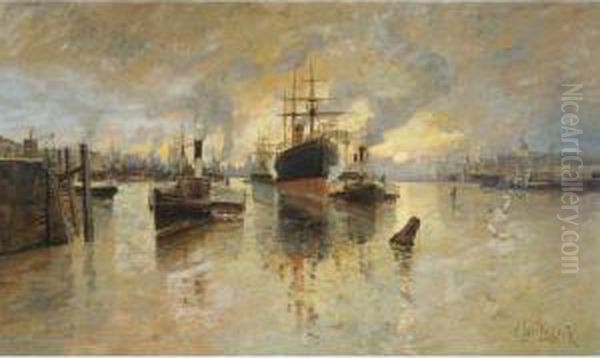
James Kay operated within a rich network of artists. His close relationship with Sir David Young Cameron (1865-1945) is particularly noteworthy. Cameron was a highly respected painter and etcher, known for his atmospheric landscapes, particularly of the Scottish Highlands. The fact that Kay married Cameron's sister suggests a close personal and likely professional bond. They shared an interest in landscape and atmosphere, though their typical subjects and styles differed.
His correspondence and activities, especially during his time as President of the SMAA, connected him with numerous other contemporary British artists. The provided information specifically mentions contact with Herbert James Gunn (1893-1994), a notable portrait and landscape painter; James Elder Christie (1847-1914), associated with the Glasgow Boys and known for figure painting; and George Clausen (1852-1944), an English painter influenced by French Naturalism and Impressionism, known for rural scenes and depictions of light.
Beyond these named individuals, Kay's milieu included the aforementioned Glasgow Boys like James Guthrie, John Lavery, Arthur Melville, and Joseph Crawhall. While his style had its own identity, he shared their commitment to modernism and direct observation. He would also have been aware of slightly earlier Scottish landscape masters like William McTaggart (1835-1910), often considered a precursor to Scottish Impressionism, known for his dynamic seascapes. Later, he would have overlapped with the Scottish Colourists – Samuel Peploe, F.C.B. Cadell, and Leslie Hunter – though their bolder, post-impressionist use of colour marked a different direction. Interaction, or at least mutual awareness, among these figures within the relatively close-knit Scottish art scene was inevitable through exhibitions and societies. His work can be seen as part of this broader flourishing of Scottish art in the late 19th and early 20th centuries.
Later Career and Legacy
James Kay continued to paint and exhibit throughout the early decades of the 20th century, remaining active until his death in 1942. His work maintained its focus on the interplay of light, atmosphere, and landscape, particularly the enduring subject of the Clyde, though like many artists, his style may have evolved subtly over time. He lived through a period that saw dramatic shifts in art, from Impressionism through Post-Impressionism, Fauvism, and the beginnings of abstraction. While Kay remained largely committed to his own form of atmospheric realism rooted in Impressionist observation, his work retained its relevance and appeal.
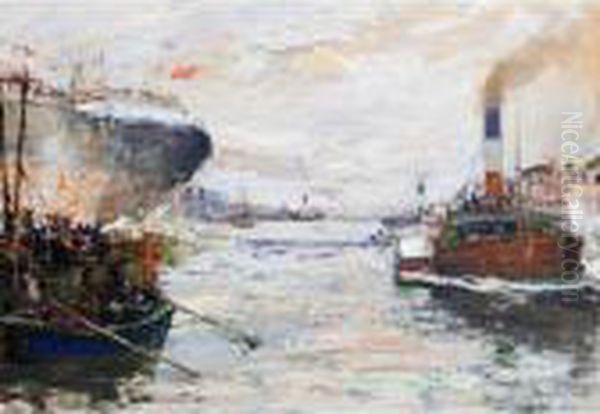
His legacy rests primarily on his powerful depictions of the River Clyde. He captured a specific moment in Scotland's industrial and maritime history with artistic flair and sensitivity. His paintings serve not only as aesthetic objects but also as historical documents, evoking the spirit of an era defined by industry and seafaring. He demonstrated that industrial subjects could be sources of profound beauty and artistic inspiration, a path also explored by artists like Camille Pissarro in his industrial Rouen scenes or Joseph Pennell in his etchings of industrial sites.
Today, James Kay's works are held in numerous public collections, including the Glasgow Museums and the National Galleries of Scotland. They are appreciated for their technical skill, their atmospheric depth, and their unique portrayal of Scotland's industrial heartland. He remains a respected figure within Scottish art history, recognised for his original contribution to landscape painting and his masterful ability to capture the distinctive light and mood of the Clyde.
Conclusion: Capturing the Spirit of the Clyde
James Kay (1858-1942) carved a unique niche for himself in the landscape of British and Scottish art. Deeply influenced by the innovations of Impressionism, he developed a highly personal and original style characterized by atmospheric sensitivity, dynamic compositions, and a keen eye for the interplay of light, water, and industry. His lifelong fascination with the River Clyde provided him with a subject matter that was both visually dramatic and historically significant, allowing him to create a body of work that chronicles the energy and grit of Scotland's industrial powerhouse.
Through celebrated paintings like Toil and Grime and River of the North, and his participation in major exhibitions both at home and abroad, Kay established a considerable reputation. His affiliations with the Royal Scottish Academy and the Royal Scottish Society of Painters in Watercolour, along with his presidency of the Scottish Modern Arts Association, cemented his standing within the art community. Connected with contemporaries like Sir David Young Cameron and part of a vibrant generation of Scottish artists exploring modernism, James Kay left behind a powerful legacy. His paintings endure as compelling testaments to his artistic skill and as evocative portals into the atmospheric world of the River Clyde during its industrial zenith.